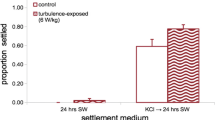Abstract
The morphology and shape of algae can affect their survival in wave-swept environments because of the hydrodynamic drag created by water flow. Studies of morphology and drag are typically conducted at relatively low water velocities, and the influence of algal morphology on drag, over the range of water velocities algae must cope with in their natural environment, remains unclear. Here, we tested the link between morphological variation and hydrodynamic drag for a dominant kelp with complex morphology (Ecklonia radiata), over a range of water velocities representative of conditions on wave-swept reefs. Our results indicated that kelps on subtidal reefs must withstand maximal orbital water velocities in excess of 2–3 m s−1. Our measurements of drag, resulting from flows ranging from 1 to 3 m s−1, revealed that shape- and width-related thallus and lamina characters were important to drag at low speed, but that total thallus area (or biomass) was the main determinant of drag at high flow. Drag coefficients converged at increasing speed suggesting that, at high flow, significant thallus reconfiguration (more streamlined shape) decoupled drag from morphology. This implies that, at peak velocities, only size (total area), not morphology, is important to drag and the probability of dislodgment.



Similar content being viewed by others
References
Akaike H (1973) Maximum likelihood identification of Gaussian autoregressive moving average models. Biometrika 60:255–265. doi:10.1093/biomet/60.2.255
Anderson MJ (2003) DISTLM forward: a FORTRAN computer program to calculate a distance-based multivariate analysis for a linear model using forward selection. Department of Statistics, University of Auckland, Auckland
Begin C, Scheibling RE (2003) Growth and survival of the invasive green alga Codium fragile ssp. tomentosoides in tide pools on a rocky shore in Nova Scotia. Bot Mar 46:404–412. doi:10.1515/BOT.2003.040
Bell EC (1999) Applying flow tank measurements to the surf zone: predicting dislodgment of the Gigartinaceae. Phycol Res 47:159–166. doi:10.1046/j.1440-1835.1999.00169.x
Blanchette CA (1997) Size and survival of intertidal plants in response to wave action: a case study with Fucus gardneri. Ecology 78:1563–1578. doi:10.1890/0012-9658(1997)078[1563:sasoip]2.0.co;2
Blanchette CA, Miner BG, Gaines SD (2002) Geographic variability in form, size and survival of Egregia menziesii around point conception, California. Mar Ecol Prog Ser 239:69–82. doi:10.3354/meps239069
Boller ML, Carrington E (2006) The hydrodynamic effects of shape and size change during reconfiguration of a flexible macroalga. J Exp Biol 209:1894–1903. doi:10.1242/jeb.02225
Buck BH, Buchholz CM (2005) Response of offshore cultivated Laminaria saccharina to hydrodynamic forcing in the North Sea. Aquaculture 250:674–691. doi:10.1016/j.aquaculture.2005.04.062
Burnham KP, Anderson DR (2002) Model selection and multimodel inference: a practical information-theoretic approach. Springer, New York
Carrington E (1990) Drag and dislodgment of an intertidal macroalga: consequences of morphological variation in Mastocarpus papillatus Kützing. J Exp Mar Biol Ecol 139:185–200. doi:10.1016/0022-0981(90)90146-4
Carrington E, Grace SP, Chopin T (2001) Life history phases and the biomechanical properties of the red alga Chondrus crispus (Rhodophyta). J Phycol 37:699–704. doi:10.1046/j.1529-8817.2001.00169.x
Connell SD, Irving AD (2008) Integrating ecology with biogeography using landscape characteristics: a case study of subtidal habitat across continental Australia. J Biogeogr 35:1608–1621. doi:10.1111/j.1365-2699.2008.01903.x
D’Amours O, Scheibling RE (2007) Effect of wave exposure on morphology, attachment strength and survival of the invasive green alga Codium fragile ssp. tomentosoides. J Exp Mar Biol Ecol 351:129–142. doi:10.1016/j.jembe.2007.06.018
Dayton PK, Tegner MJ, Parnell PE, Edwards PB (1992) Temporal and spatial patterns of disturbance and recovery in a kelp forest community. Ecol Monogr 62:421–445. doi:10.2307/2937118
de Bettignies T, Thomsen MS, Wernberg T (2012a) Wounded kelps: patterns and susceptibility to breakage. Aquat Biol (in press). doi:10.3354/ab00471
de Bettignies T, Wernberg T, Lavery P, Vanderklift MA, Mohring M (2012b) Contrasting mechanisms of dislodgement and erosion contribute to production of kelp detritus (in review)
Denny M (1994) Extreme drag forces and the survival of wind- and water-swept organisms. J Exp Biol 194:97–115
Denny M (1995) Predicting physical disturbance: mechanistic approaches to the study of survivorship on wave-swept shores. Ecol Monogr 65:371–418. doi:10.2307/2963496
Denny M (1998) The menace of momentum: dynamic forces on flexible organisms. Limnol Oceanogr 43:955–968
Denny MW (2006) Ocean waves, nearshore ecology, and natural selection. Aquat Ecol 40:439–461. doi:10.1007/s10452-004-5409-8
Denny M, Gaylord B (2002) The mechanics of wave-swept algae. J Exp Biol 205:1355–1362
Dudgeon SR, Johnson AS (1992) Thick vs. thin: thallus morphology and tissue mechanics influence differential drag and dislodgement of two co-dominant seaweeds. J Exp Mar Biol Ecol 165:23–43. doi:10.1016/0022-0981(92)90287-k
Evans SN, Abdo DA (2010) A cost-effective technique for measuring relative water movement for studies of benthic organisms. Mar Freshw Res 61:1327–1335. doi:10.1071/MF10007
Fowler-Walker M, Wernberg T, Connell S (2006) Differences in kelp morphology between wave sheltered and exposed localities: morphologically plastic or fixed traits? Mar Biol 148:755–767. doi:10.1007/s00227-005-0125-z
Gaylord B (2000) Biological implications of surf-zone flow complexity. Limnol Oceanogr 45:174–188
Gaylord B, Blanchette CA, Denny MW (1994) Mechanical consequences of size in wave-swept algae. Ecol Monogr 64:287–313. doi:10.2307/2937164
Harder D, Speck O, Hurd C, Speck T (2004) Reconfiguration as a prerequisite for survival in highly unstable flow-dominated habitats. J Plant Growth Regul 23:98–107. doi:10.1007/s00344-004-0043-1
Haring R, Carpenter R (2007) Habitat-induced morphological variation influences photosynthesis and drag on the marine macroalga Pachydictyon coriaceum. Mar Biol 151:243–255. doi:10.1007/s00227-006-0474-2
Johnson A, Koehl M (1994) Maintenance of dynamic strain similarity and environmental stress factor in different flow habitats: thallus allometry and material properties of a giant kelp. J Exp Biol 195:381–410
Kawamata S (2001) Adaptive mechanical tolerance and dislodgement velocity of the kelp Laminaria japonica in wave-induced water motion. Mar Ecol Prog Ser 211:89–104. doi:10.3354/meps211089
Kirkman H (1981) The first year in the life history and the survival of the juvenile marine macrophyte, Ecklonia radiata (Turn.) J Agardh. J Exp Mar Biol Ecol 55:243–254. doi:10.1016/0022-0981(81)90115-5
Kirkman H (1989) Growth, density and biomass of Ecklonia radiata at different depths and growth under artificial shading off Perth, Western Australia. Mar Freshw Res 40:169–177. doi:10.1071/MF9890169
Koehl MAR (1984) How do benthic organisms withstand moving water? Am Zool 24:57–70. doi:10.1093/icb/24.1.57
Koehl MAR (1996) When does morphology matter? Annu Rev Ecol Syst 27:501–542. doi:10.1146/annurev.ecolsys.27.1.501
Koehl MAR (1999) Ecological biomechanics of benthic organisms: life history, mechanical design and temporal patterns of mechanical stress. J Exp Biol 202:3469–3476
Koehl MAR (2000) Mechanical design and hydrodynamics of blade like algae: Chondracanthus exasperatus. In: Spatz HC, Speck T (eds) Third international plant biomechanics. Thieme Verlag, Stuttgart, pp 295–308
Koehl MAR, Alberte RS (1988) Flow, flapping, and photosynthesis of Nereocystis luetkeana: a functional comparison of undulate and flat blade morphologies. Mar Biol 99:435–444. doi:10.1007/bf02112137
Krumhansl KA, Scheibling RE (2011) Detrital production in Nova Scotian kelp beds: patterns and processes. Mar Ecol Prog Ser 421:67–82. doi:10.3354/meps08905
Lemm AJ, Hegge BJ, Masselink G (1999) Offshore wave climate, Perth (Western Australia), 1994–1996. Mar Freshw Res 50:95–102. doi:10.1071/MF98081
Mach KJ, Nelson DV, Denny MW (2007) Techniques for predicting the lifetimes of wave-swept macroalgae: a primer on fracture mechanics and crack growth. J Exp Biol 210:2213–2230. doi:10.1242/jeb.001560
McArdle BH, Anderson MJ (2001) Fitting multivariate models to community data: a comment on distance-based redundancy analysis. Ecology 82:290–297. doi: 10.1890/0012-9658(2001)082[0290:fmmtcd]2.0.co;2
Milligan KLD, De Wreede RE (2004) Morphological variations do not effectively reduce drag forces at high wave-exposure for the macroalgal species, Hedophyllum sessile (Laminariales, Phaeophyta). Phycologia 43:236–244. doi:10.2216/i0031-8884-43-3-236.1
Phillips JC, Kendrick GA, Lavery PS (1997) A test of a functional group approach to detecting shifts in macroalgal communities along a disturbance gradient. Mar Ecol Prog Ser 153:125–138. doi:10.3354/meps153125
Roberson LM, Coyer JA (2004) Variation in blade morphology of the kelp Eisenia arborea: incipient speciation due to local water motion? Mar Ecol Prog Ser 282:115–128. doi:10.3354/meps282115
Seymour RJ, Tegner MJ, Dayton PK, Parnell PE (1989) Storm wave induced mortality of giant kelp, Macrocystis pyrifera, in Southern California. Estuar Coast Shelf Sci 28:277–292. doi:10.1016/0272-7714(89)90018-8
Smale DA, Wernberg T, Vance T (2011) Community development on subtidal temperate reefs: the influences of wave energy and the stochastic recruitment of a dominant kelp. Mar Biol 158:1757–1766. doi:10.1007/s00227-011-1689-4
Stewart HL, Carpenter RC (2003) The effects of morphology and water flow on photosynthesis of marine macroalgae. Ecology 84:2999–3012. doi:10.1890/02-0092
Thomsen MS (2004) Species, thallus size and substrate determine macroalgal break force and break location in a low-energy soft-bottom lagoon. Aquat Bot 80:153–161. doi:10.1016/j.aquabot.2004.08.002
Thomsen MS, Wernberg T, Kendrick GA (2004) The effect of thallus size, life stage, aggregation, wave exposure and substratum conditions on the forces required to break or dislodge the small kelp Ecklonia radiata. Bot Mar 47:454–460. doi:10.1515/BOT.2004.068
Utter B, Denny M (1996) Wave-induced forces on the giant kelp Macrocystis pyrifera (Agardh): field test of a computational model. J Exp Biol 199:2645–2654
Vogel S (1984) Drag and flexibility in sessile organisms. Am Zool 24:37–44. doi:10.1093/icb/24.1.37
Vogel S (1994) Life in moving fluids: the physical biology of flow. Bull Math Biol 57:949–951. doi:10.1007/bf02458306
Wainwright PC (1996) Ecological explanation through functional morphology: the feeding biology of sunfishes. Ecology 77:1336–1343. doi:10.2307/2265531
Wernberg T (2005) Holdfast aggregation in relation to morphology, age, attachment and drag for the kelp Ecklonia radiata. Aquat Bot 82:168–180. doi:10.1016/j.aquabot.2005.04.003
Wernberg T, Connell SD (2008) Physical disturbance and subtidal habitat structure on open rocky coasts: effects of wave exposure, extent and intensity. J Sea Res 59:237–248. doi:10.1016/j.seares.2008.02.005
Wernberg T, Thomsen MS (2005) The effect of wave exposure on the morphology of Ecklonia radiata. Aquat Bot 83:61–70. doi:10.1016/j.aquabot.2005.05.007
Wernberg T, Vanderklift MA (2010) Contribution of temporal and spatial components to morphological variation in the kelp Ecklonia (Laminariales). J Phycol 46:153–161. doi:10.1111/j.1529-8817.2009.00772.x
Wernberg T, Coleman M, Fairhead A, Miller S, Thomsen M (2003a) Morphology of Ecklonia radiata (Phaeophyta: Laminarales) along its geographic distribution in south-western Australia and Australasia. Mar Biol 143:47–55. doi:10.1007/s00227-003-1069-9
Wernberg T, Kendrick GA, Phillips JC (2003b) Regional differences in kelp-associated algal assemblages on temperate limestone reefs in south-western Australia. Divers Distrib 9:427–441. doi:10.1046/j.1472-4642.2003.00048.x
Acknowledgments
TdB was funded through an ECU postgraduate award. Additional funding was obtained from the Western Australian Marine Science Institution (TdB). TW was funded by the Australian Research Council. We thank J. P. Escaňo Roepstorff, T. Minutoli Tegrimi, F. Vitelli, S. Luret and P. Bouvais for assistance in the field, D. Goodall and G. Maguire for comments on the early manuscript and editing, and D. Thomson for the calibration of the accelerometers.
Author information
Authors and Affiliations
Corresponding author
Additional information
Communicated by K. Bischof.
Rights and permissions
About this article
Cite this article
de Bettignies, T., Wernberg, T. & Lavery, P.S. Size, not morphology, determines hydrodynamic performance of a kelp during peak flow. Mar Biol 160, 843–851 (2013). https://doi.org/10.1007/s00227-012-2138-8
Received:
Accepted:
Published:
Issue Date:
DOI: https://doi.org/10.1007/s00227-012-2138-8




